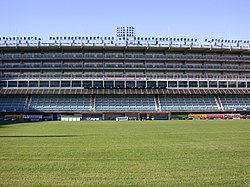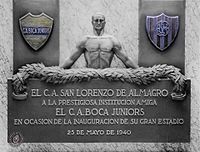La Bombonera: Difference between revisions
GreenC bot (talk | contribs) |
Rescuing 2 sources and tagging 0 as dead. #IABot (v1.2.7.1) |
||
| Line 58: | Line 58: | ||
==Redevelopment== |
==Redevelopment== |
||
[[File:Barrio de La Boca (6923434011).jpg|thumb|right|200px|The stadium from inside.]] |
[[File:Barrio de La Boca (6923434011).jpg|thumb|right|200px|The stadium from inside.]] |
||
There are planned improvements for the stadium, including measures to ease crowd congestion, use of new technology in the stadium and improved corporate facilities. These include:<ref name="boca-iso9001">{{cite web|url=http://www.bocajuniors.com.ar/english/elclub_iso9001.php|title=First in the World - Processes that have been certified with the maximum distinction|publisher=[[Club Atlético Boca Juniors]]|accessdate=2008-11-07 |archiveurl= |
There are planned improvements for the stadium, including measures to ease crowd congestion, use of new technology in the stadium and improved corporate facilities. These include:<ref name="boca-iso9001">{{cite web|url=http://www.bocajuniors.com.ar/english/elclub_iso9001.php |title=First in the World - Processes that have been certified with the maximum distinction |publisher=[[Club Atlético Boca Juniors]] |accessdate=2008-11-07 |archiveurl=https://web.archive.org/web/20080528190403/http://www.bocajuniors.com.ar/english/elclub_iso9001.php |archivedate=2008-05-28 |deadurl=yes |df= }}</ref> |
||
*'''Main gate, museum and megastore''': Work is planned to be done on the main access to the stadium at 805 Brandsen which will include the construction of a [[megastore]], and to then connect the main access with the store and the club's museum. |
*'''Main gate, museum and megastore''': Work is planned to be done on the main access to the stadium at 805 Brandsen which will include the construction of a [[megastore]], and to then connect the main access with the store and the club's museum. |
||
| Line 112: | Line 112: | ||
==External links== |
==External links== |
||
{{commons category|Estadio Alberto J. Armando}} |
{{commons category|Estadio Alberto J. Armando}} |
||
*[http://www.bocampeonweb.com.ar/english/bombonera3.htm Images of La Bombonera] |
*[https://web.archive.org/web/20081220132359/http://www.bocampeonweb.com.ar:80/english/bombonera3.htm Images of La Bombonera] |
||
*[http://www.football-match.de/buenos-aires/ Atmosphere at La Bombonera] |
*[http://www.football-match.de/buenos-aires/ Atmosphere at La Bombonera] |
||
Revision as of 03:34, 11 November 2016
La Bombonera | |
  | |
 | |
| Full name | Estadio Alberto J. Armando |
|---|---|
| Former names | Estadio Boca Juniors (1940-1986) Estadio Camilo Cichero (1986–2000) |
| Location | Brandsen 805 CP 1161 La Boca, Buenos Aires |
| Owner | Boca Juniors |
| Capacity | 49,000[2] |
| Record attendance | 57,395 (Boca-San Lorenzo, 25 May 1940)[3] |
| Field size | 105 x 68 m |
| Surface | Grass |
| Construction | |
| Broke ground | February 18, 1938 |
| Built | 1938-1940 |
| Opened | May 25, 1940[1] |
| Renovated | 1995-96 |
| Architect | José Luis Delpini, Viktor Sulčič, Raúl Bes |
| Tenants | |
| 1940-present | |
The Estadio Alberto J. Armando (formerly the Estadio Camilo Cichero) is a stadium located in La Boca district of Buenos Aires. Widely known as La Bombonera (Spanish pronunciation: [la βomboˈneɾa]; Template:Lang-en[4]) due to its shape, with a "flat" stand on one side of the pitch and three steep stands round the rest of the stadium.[5][6] It has a capacity of 49,000.[2]
The stadium is owned by Boca Juniors, one of Argentina's top football clubs. The unusual shape of the stadium has led to it having excellent acoustics and the Boca support being nicknamed "La Doce" (The 12th man).[5]
The pitch at La Bombonera is the minimum size required under FIFA regulations - 105m x 68m.
The stadium, as well as being the home of Boca Juniors, is also used as a concert venue. Past performers at La Bombonera have included Lenny Kravitz, Sir Elton John, James Blunt, the Bee Gees, the Backstreet Boys, and Cast having performed there.[7]
History

Construction began on the stadium on February 18, 1938, and Boca played their home matches at the Ferro Carril Oeste Stadium until the new stadium was built. The stadium finally opened on May 25, 1940, with a friendly match between Boca and San Lorenzo, which the home side won 2-0 with both goals scored by Ricardo Alarcón. The stadium originally had two tiers, and in 1949 the club decided to add a third tier, which was completed in 1953;[8] this third tier gave the stadium its enduring nickname: La Bombonera.[5]
The stadium was named on April 20, 1986, by team President Antonio Alegre in honor of Camilo Cichero, a former team president under whose tenure work on La Bombonera began. It was renamed on December 27, 2000, by team President Mauricio Macri in honor of Alberto Armando, team president during its resurgence during the 1960s as well as a former business partner of his father Francisco Macri. The stadium was expanded and modernized during Macri's tenure, notably with the addition in 1996 of a fourth tier; and a wing housing a press area, VIP boxes, a museum, and offices. The stadium's exterior was later decorated with works by painters Rómulo Macció and Pérez Celis.[9]
Facilities
La Bombonera currently has a capacity of around 49,000 and the club's popularity make tickets hard to find, especially for the Superclásico derby against River Plate.[6]
Out of its capacity of 49,000, there are 37,538 seats, 2780 are boxes and 8,682 standing. Both its interior and exterior are lined with a number of murals painted by the artist Pérez Celis depicting many of the club's legendary players and aspects of the district's culture, such as the life of Italian immigrants.[10]
In 1996 a small stand was built on the 4th side, which had been largely open until then, except for some VIP boxes.[11]
Diego Maradona, who played for and supports Boca Juniors, has his own executive box at the stadium.[6]
There are three parking lots at the stadium for members.[12]
Redevelopment

There are planned improvements for the stadium, including measures to ease crowd congestion, use of new technology in the stadium and improved corporate facilities. These include:[13]
- Main gate, museum and megastore: Work is planned to be done on the main access to the stadium at 805 Brandsen which will include the construction of a megastore, and to then connect the main access with the store and the club's museum.
- Third tier:Remodelling work to install further seating and improve spectator comfort.
- Stadium gates: Building work to improve access and prevent crowd congestion is underway. The first phase focuses on improving access to the executive boxes and premium seats. In addition, new software and hardware will improve access control with regard to safety and quickness to prevent crowd congestion.
- Creation of a corporate area: Businesses will have an area in the stadium with VIP service. One section in the second tier, is being re-designed with two executive boxes and more comfortable seating. The service will also provide businesses with season tickets to allow them to invite clients. It also includes transportation, museum visits and catering services.
International Friendly Matches
| Date | Local | Result | Visit |
|---|---|---|---|
| 8 January 1971 | 3-1 | ||
| 27 February 1977 | 5-1 | ||
| 29 May 1977 | 3-1 | ||
| 5 June 1977 | 1-3 | ||
| 12 June 1977 | 1-1 | ||
| 18 June 1977 | 1-1 | ||
| 26 June 1977 | 0-0 | ||
| 29 March 1978 | 3-1 | ||
| 5 April 1978 | 2-0 | ||
| 19 April 1978 | 3-1 | ||
| 3 May 1978 | 3-0 | ||
| 26 November 1992 | 2-0 | ||
| 16 November 1997 | 1-1 | ||
| 21 November 2012 | 2-1 |
Boca Museum
The Passion of Boca Juniors Museum (Spanish: Museo de la Pasión Boquense) was opened by Mauricio Macri,[14][15] and is located within the stadium. It is on two floors and chronicles the club's rise from 1905 to the present day. One of the exhibits in the museum is a giant football with 360-degree footage of the club's fans and players at a match. The museum also includes a Hall of fame and a large mural of Diego Maradona. Also included are non-football items such as the specially commissioned blue and gold guitar played by Lenny Kravitz when he performed at La Bombonera in 2005.[7][16]
See also
References
- ^ http://www.worldofstadiums.com/south-america/argentina/estadio-alberto-j-armando/
- ^ a b "La Bombonera En Numéros". La Bombonera (in Spanish). Boca Juniors. Retrieved 6 April 2012.
- ^ "Ranking the Top 10 Most Iconic Stadiums in World Football". 12 April 2013.
- ^ Ben Groundwater (20 September 2010). "Want to get to know a country? Head for the stadium". The Age. Fairfax Media. Retrieved 26 April 2013.
- ^ a b c "10 Intimidating Stadiums (Worldwide)". mifielddynamo.com. Retrieved 2008-11-07.
- ^ a b c "Buenos Aires: In a liga of its own". The Independent. 27 January 2007. Archived from the original on 2008-01-18. Retrieved 2008-11-07.
- ^ a b "Estadio Boca Juniors Review". Fodor's. Retrieved 2008-11-08.
- ^ "The Stadium". Club Atlético Boca Juniors. Archived from the original on 2008-07-04. Retrieved 2008-11-07.
- ^ "Boca Juniors y sus estadios". Club Atlético Boca Juniors.
- ^ "Fochada de la Bombonera". Bocacampeonweb. Retrieved 2008-11-08. [dead link]
- ^ "La Bombonera". The Stadium Guide. Retrieved 22 March 2013.
- ^ "El Estadio: Alberto J. Armando" (in Spanish). Agrupación Nuevo Boca. Retrieved 29 January 2013.
- ^ "First in the World - Processes that have been certified with the maximum distinction". Club Atlético Boca Juniors. Archived from the original on 2008-05-28. Retrieved 2008-11-07.
{{cite web}}: Unknown parameter|deadurl=ignored (|url-status=suggested) (help) - ^ Neumann, Jeannette (1 May 2008). "In Argentina, fans go wild for Boca Juniors". USA Today. Retrieved 2008-11-07.
- ^ "Buenos Aires Attractions - Boca Juniors Stadium and Museum". New York Times. Archived from the original on February 24, 2007. Retrieved 2008-11-07.
{{cite web}}: Unknown parameter|deadurl=ignored (|url-status=suggested) (help) - ^ "El Museo de la Pasión Bocquense" (in Spanish). Club Atlético Boca Juniors. Retrieved 2008-11-08.
